Growing Parsley from Seed: A Step-by-Step Guide
Updated: 25 Apr 2024
113
Parsley is a biennial plant that thrives in temperate climates. It has rich, green leaves packed with flavor. It is used as a garnish or a critical ingredient in cooking and has a constant supply of fresh herbs.
Parsley and mint are often used together in dishes such as salads, sauces, and soups. Both herbs have a slightly peppery, refreshing flavor and are high in vitamins A and C and minerals like potassium and iron.
In this guide, I will walk you through the process of growing parsley from seed, step by step, ensuring that even beginners can succeed in this gardening adventure.

Benefits of Growing Parsley from Seed
Growing your parsley at home is significantly more cost-effective than purchasing mature plants or repeatedly buying fresh parsley from the store. It is also accessible from harmful pesticides and chemicals, making it healthier for you and your family.
Another benefit is the sheer satisfaction of nurturing a plant from its infancy. There’s something incredibly fulfilling about tending to a plant and watching it flourish under your care. Moreover, parsley plants grown from seed tend to be more robust and resilient, acclimated to your specific garden conditions from the outset.
Additionally, parsley is an excellent companion plant. It attracts beneficial insects to your garden, such as predatory wasps and hoverflies, which help control pest populations. It also allows you to select from various varieties, including flat-leaf (Italian) and curly-leaf types, each with a unique flavor profile and culinary uses.
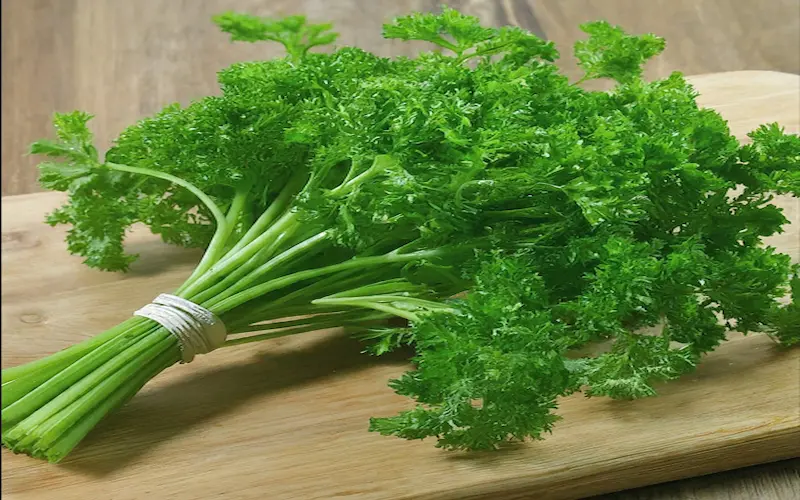
Essential Tools and Equipment
To begin your parsley-growing journey, you must gather a few essential tools and equipment. First, you’ll need high-quality parsley seeds. Purchasing seeds from a reputable source is necessary to ensure reasonable germination rates. To start the seeds indoors, you will need a seed tray or small pots and a high-quality seed starting mix that’s well-draining and fertile.
Invest in a small watering can or spray bottle for gentle watering that won’t disturb the delicate seeds. A plastic cover or clear dome will help retain moisture and warmth, creating a greenhouse effect ideal for seed germination. Labels or markers are also handy for keeping track of your parsley seeds, significantly if you’re growing multiple varieties or other herbs simultaneously.
As your parsley plants grow, you’ll need larger pots or a prepared garden bed for transplanting, along with standard gardening tools such as a trowel, pruning shears, and a garden fork. A balanced, organic fertilizer will support healthy growth, and mulch will help retain soil moisture and suppress weeds. With these tools and materials ready, you can start your parsley-growing adventure.
Choosing the Right Seeds
Selecting the right seeds is crucial when learning how to grow parsley from seed. There are two main types of parsley: flat-leaf and curly-leaf. Flat-leaf or Italian parsley has a more robust flavor and is often preferred for culinary uses. With its decorative appearance, curly-leaf parsley is milder in taste and commonly used as a garnish.
When choosing parsley seeds, look for varieties known for their vigor and high germination rates. Consider the available climate and space; some types may be better suited to growing in pots or small gardens. Organic seeds can be an excellent choice for those looking to maintain an organic garden.
Remember to check the seed packet for information on the plant’s growth habits, space requirements, and any resistance to common diseases. This information will help you plan your garden space and increase the likelihood of a successful harvest. With the right seeds, you’re ready to move on to the next step.
Preparing the Soil for Planting Parsley Seeds
Soil preparation is a critical step in this journey. Parsley prefers well-draining soil rich in organic matter. Before planting, working the soil to a fine tilth is essential, breaking up any large clumps and removing debris. This creates an ideal environment for the delicate roots of parsley seedlings to spread out and absorb nutrients.
Incorporating compost or well-rotted manure into the soil improves its fertility and structure. A balanced pH level is also essential for parsley, so if your soil is too acidic or alkaline, you may need to adjust it with lime or sulfur, respectively. Ensuring the soil is moist but not soggy is critical to successful germination. A little effort in preparing the soil goes a long way in ensuring a bountiful parsley harvest.
Once the soil is prepared, it’s time to consider the planting location. Parsley thrives in full sun to partial shade. If you’re planting in a garden bed, choose a spot that receives at least six hours of sunlight daily. Select a pot at least 6 to 8 inches deep for container gardening with adequate drainage holes to prevent water-logging.
Planting Parsley Seeds Indoors
Starting parsley seeds indoors is a great way to get a head start on the growing season. Parsley can take a few weeks to germinate, so beginning indoors allows you to control the environment and maximize germination rates. Fill your seed trays or pots with your prepared seed starting mix, leaving a little space at the top.
Sow the parsley seeds sparingly, as they are small and can quickly become overcrowded. Cover them lightly with a thin layer of the seed starting mix, as parsley seeds need light to germinate. To avoid disturbing them, water the seeds gently with a spray bottle or a watering can with a fine rose attachment.
Place the trays or pots in a warm spot with a consistent temperature of around 70°F (21°C). A plastic cover or clear dome can help keep the moisture and warmth, creating an ideal microclimate for seed germination. Be patient, as parsley seeds can sprout in 2 to 5 weeks.
Monitor the soil’s moisture level regularly, keeping it consistently moist but not soggy. Once the seeds sprout, remove the cover and place the seedlings in a sunny spot or under grow lights to encourage vigorous growth. Proper indoor starting will set a solid foundation for healthy parsley plants.
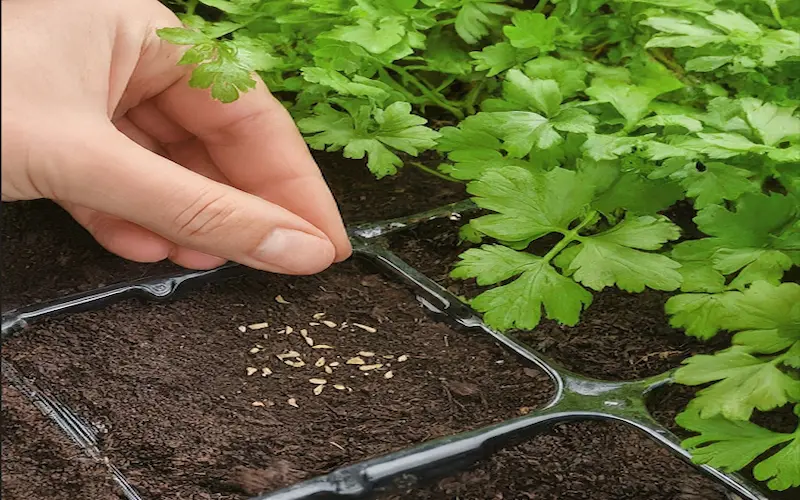
Caring for Parsley Seedlings
Once your parsley seeds have sprouted, proper care is essential for the young seedlings to thrive. Ensure they receive plenty of light; if natural light is insufficient, supplement it with grow lights placed a few inches above the seedlings. Consistent lighting will prevent the seedlings from becoming leggy and weak.
Watering is crucial at this stage; the soil should be kept evenly moist, but be careful not to overwater as this can lead to damping-off, a fungal disease that can kill seedlings. A balanced liquid fertilizer, diluted to half strength, can be applied every few weeks to provide essential nutrients for growth.
As the seedlings grow, they may need to be thinned to prevent overcrowding, which can stifle their development and increase the disease risk. Please select the most vigorous seedlings to keep and gently remove the others by snipping them at the soil level with scissors. This thinning process ensures that each parsley plant has enough space and resources to mature correctly.
Caring for parsley seedlings indoors also involves acclimating them to outdoor conditions before transplanting. This process, known as hardening off, involves gradually exposing the seedlings to the outside environment over 7-10 days. Start by placing them outside for a few hours in a sheltered location, gradually increasing their time outdoors daily. This step is crucial to prevent shock and ensure a smooth transition from indoors to the garden bed.
Transplanting Parsley Seedlings Outdoors
When the weather has warmed and the parsley seedlings have been properly hardened off, it’s time to transplant them outdoors. Choose a cloudy day or an evening to transplant, as the cooler temperatures and reduced sunlight will help ease the seedlings’ transition and reduce stress.
Before transplanting, ensure the outdoor soil is prepared as meticulously as the indoor starting mix. It should be loose, rich in organic matter, and well-draining. Dig holes slightly larger than the root balls of the seedlings, spacing them about 8 to 10 inches apart to allow for ample growth.
Carefully remove each seedling from its container, being mindful not to disturb the delicate roots. Place each plant in its respective hole and gently backfill with soil, firming it around the base of the seedling to eliminate air pockets. Water the transplanted seedlings thoroughly to help settle the soil around the roots and provide necessary hydration.
For the first few weeks after transplanting, watch your parsley plants closely. They may require additional watering as they establish themselves in their new environment. Organic mulch can be added to conserve moisture, regulate soil temperature, and discourage weeds. Your parsley plants will thrive outdoors correctly and reward you with a lush, aromatic harvest.
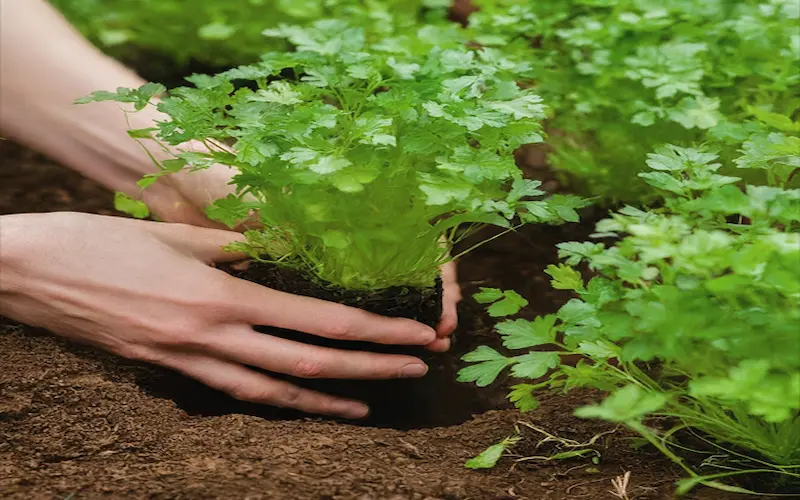
Growing Parsley In Pots
It is an excellent option for those with limited garden space or who prefer container gardening. The process is similar to planting in the ground, with additional considerations for container environments.
First, select a pot at least 6 to 8 inches deep with drainage holes to prevent waterlogging. Fill the pot with a high-quality potting mix designed for container planting, ensuring good drainage and nutrient content. Sow the parsley seeds directly into the pot, following the same guidelines for depth and spacing as you would for a garden bed.
Water the seeds gently and place the pot in a sunny spot, ensuring it receives at least six hours of sunlight daily. Parsley grown in pots may require more frequent watering than garden-grown parsley, as containers can dry out more quickly. Be mindful of the potting mix’s moisture level, keeping it moist but not soggy.
Regularly feeding with a diluted liquid fertilizer will provide the additional nutrients needed for container-grown herbs as the parsley plants grow. Watch for any signs of pests or diseases and address them promptly to maintain the health of your parsley plants. With the proper care, growing parsley in a pot from seed can be convenient and fruitful.
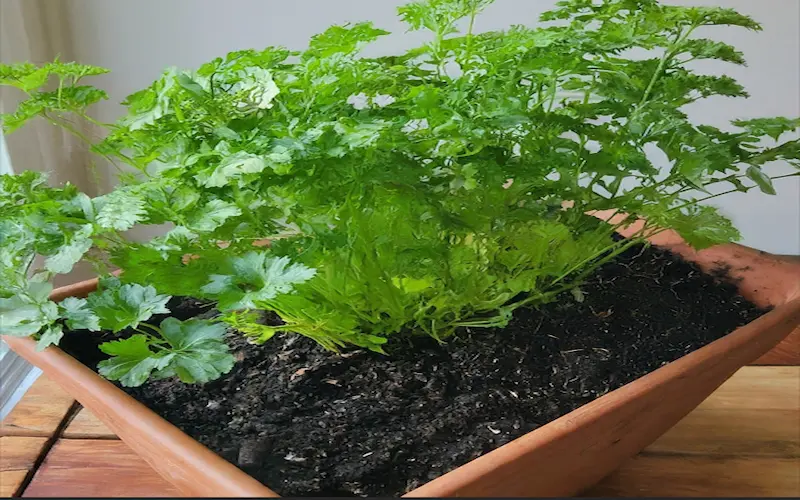
Tips for Successful Parsley Seed Germination
Germinating parsley seeds can sometimes be challenging, but you can increase your success rate with a few tips. First, remember that parsley seeds have a naturally slow and uneven germination process. To speed up germination, some gardeners recommend soaking the seeds in warm water for 24 hours before planting. This softens the seed coat and can help trigger the germination process.
Maintaining consistent soil temperature and moisture levels is crucial for successful germination. A heat mat can provide a steady source of warmth, and covering the seed tray with a clear dome or plastic wrap helps retain humidity. Keep the soil moist but not waterlogged, as too much water can cause the seeds to rot.
Patience is key when waiting for parsley seeds to sprout. It can take several weeks, so keep going even if you don’t see immediate results. Once the seeds germinate, ensure they receive enough light to prevent them from becoming leggy and weak. Thin the seedlings if necessary to give each plant sufficient space to grow.
Following these tips and understanding the unique needs of parsley seeds can improve your chances of successful germination and set the stage for a healthy crop.
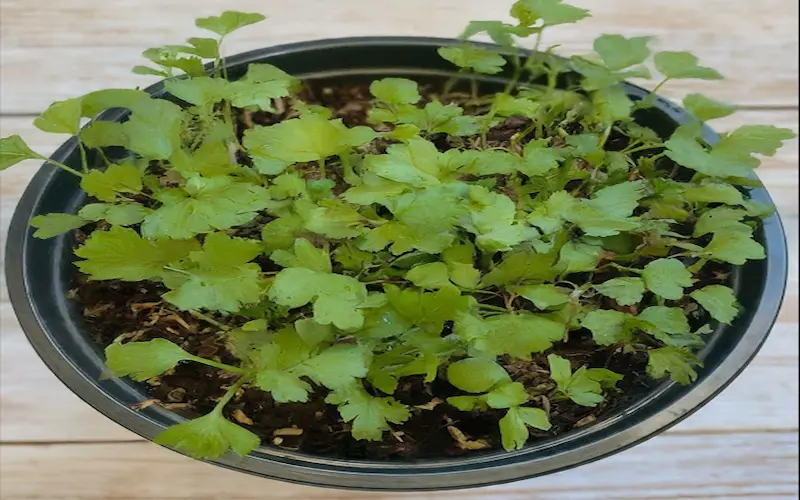
Common Problems and Solutions
Growing parsley from seed can occasionally encounter problems, but most are easily preventable or solvable. One common issue is damping-off, a fungal disease that affects seedlings. To prevent this, use clean containers and a sterile seed starting mix. Avoid overwatering and provide good air circulation around the seedlings.
Another potential problem is pests, such as aphids or whiteflies, which can attack parsley plants. Inspect your plants regularly, and if pests are spotted, use insecticidal soap or neem oil to control the infestation. Follow the application instructions carefully to protect your plants and the environment.
Parsley plants may also suffer from nutrient deficiencies, manifesting as yellowing leaves or stunted growth. This can be addressed by applying a balanced, organic fertilizer according to the manufacturer’s recommendations. Ensuring the soil is rich in organic matter from the start can also help prevent these issues.
By identifying these common problems and addressing them promptly, you can maintain the health and vitality of your parsley plants. You’ll overcome these challenges and enjoy a bountiful harvest with proper care.
Harvesting and Storing Parsley
Harvesting parsley is a rewarding part of the growing process. Begin harvesting when the plants have at least three segments of leaves. Cut the outer, more mature leaves at the base, leaving the inner sections to grow. Regular harvesting encourages the plant to produce more foliage, extending the harvesting season.
You have several options for storing parsley. Fresh parsley can be kept in the refrigerator in a glass of water with the stems submerged or wrapped in a damp paper towel and placed in a plastic bag. For more extended storage, parsley can be dried or frozen. To dry parsley, hang bunches in a warm, well-ventilated area away from direct sunlight.
Once dried, crumble the leaves and store them in an airtight container. To freeze parsley, chop the leaves and place them in an ice cube tray with water, or freeze them flat in a single layer on a baking sheet before transferring them to a freezer bag.
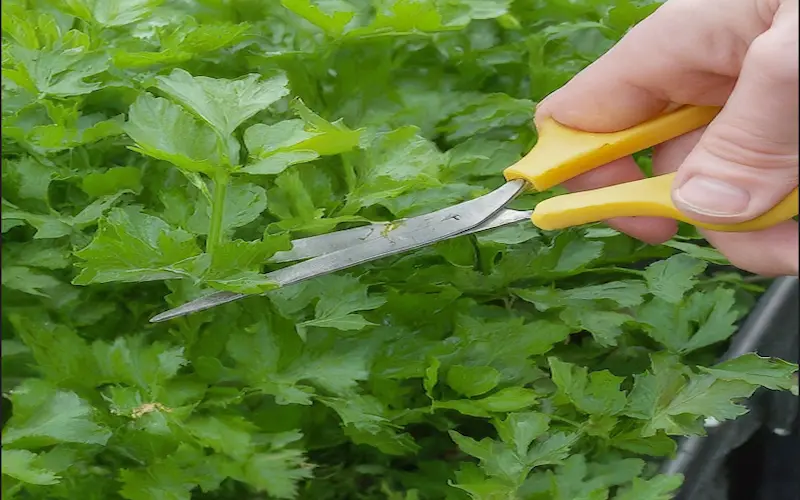
Conclusion
Growing parsley from seed is a beautiful journey that can enhance your garden and kitchen. Following the steps outlined in this guide, you can successfully cultivate this aromatic herb and reap its many benefits. From the initial selection of seeds to the joy of harvesting, each process phase brings its rewards.
As a gardener, the knowledge and satisfaction gained from nurturing a plant from seed to harvest are invaluable. I encourage you to embrace the experience and enjoy the fresh, vibrant flavor of homegrown parsley in your cooking. With patience, care, and the tips in this guide, you’ll be well on your way to becoming a parsley-growing expert.
Please Write Your Comments